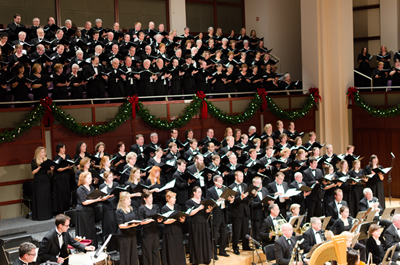Any performance of one of the massive symphonies of Gustav Mahler is a special occasion. It was certainly ambitious on the part of The Music Center to schedule the composer’s Symphony No. 1 in D Major, “The Titan” (1899) with the community musicians of both the Philharmonia of Greensboro and, from their neighbor in Virginia, the Danville (Virginia) Symphony Orchestra. Each orchestra rehearsed separately before having two joint rehearsals prior to back-to-back performances in each city. This was facilitated by the fact both orchestras have the same very experienced music director, Peter Perret, who was Music Director of the Winston-Salem Symphony from 1978-2004 and has enjoyed an active international career. The skills of members of community orchestras vary widely but this joint effort produced a great many rewards for the music lovers who heard this concert for free in the fine acoustics of Dana Auditorium on the Guilford College campus.
Perret spoke briefly to provide background and context before the performance. He said Mahler grew up in a predominately Jewish section of Iglau, in Bohemia, now the Czech Republic but then part of the Austro-Hungarian Empire. His home was near a military base, so young Mahler grew up hearing martial music; klezmer music was popular, too. All biographies stress the influence of funeral marches as well as Mahler’s guilt over the death of his beloved older brother. He was obsessed by folk and military music and haunted by death, and these elements are found throughout all his symphonies.
The Symphony No. 1 in D, in four movements, calls for a large orchestra which this merging of two community orchestras came close to meeting. There were an impressive nine French horns and a doubling of the other brass and woodwinds. The massive string sections, short only to four double bases, allowed for weighty ppp passages and good balance with the brass.
The quiet, eerie opening evokes the awaking of Nature in the morning. Mahler makes use of the melody of the song “Ging heut’ Morgen übers Feld” (“I crossed the Meadow at Morn”) from his earlier song cycle Lieder eines fahrenden Gesellen. The second movement is night music, inspired by some illustrations of a trumpeter serenading his love across the Rhine by moonlight. The third movement is a macabre funeral march that begins with the double-basses playing the melody of “Frère Jacques” very slowly, in a minor key. The finale opens with a harsh crash and develops from F Minor to a triumphant D Major.
Perret held a good rein on his forces, keeping each movement within his solid interpretation of the whole symphony. Off-stage trumpets during the opening were handled beautifully. The cello section played its melody part with warmth and good ensemble. The massed strings generally were effective whether in loud sections or hushed passages. Several players were consistently outstanding: timpanist Lee Ponting, first horn Steve Bernsdorf, principal trumpet Don Wolfe, oboist Susan Kundert, and concertmaster Eve Hubbard. The viola section was superb in the turn of mood during the last third of the last movement.
Note: The Philharmonia of Greensboro is serving as orchestra for the Choral Society of Greensboro’s performance of Schubert Mass in E-flat on November 9. The Choral Scociety is celebrating its 30th year.











